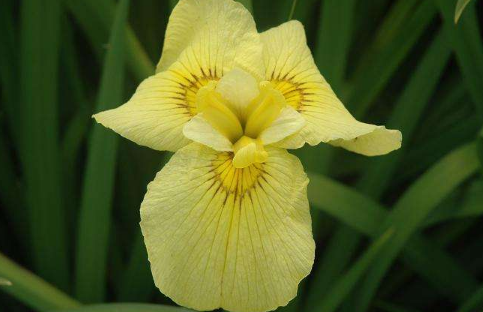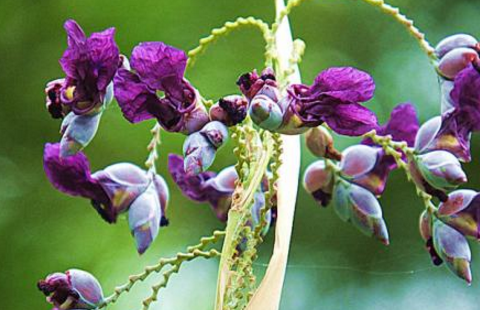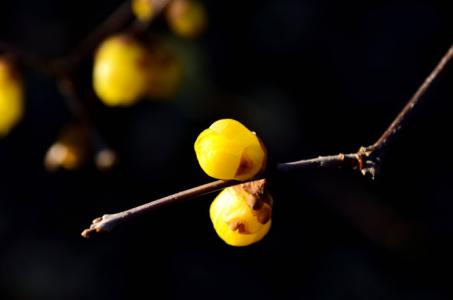Culture methods of Acorus calamus
1. Soil
Acorus calamus likes loose and breathable sandy soil, which can be mixed with vermiculite, river sand and nutritious soil, and the loam rich in humus is the best.
two。 Moisture content
Calamus likes the humid environment, daily watering to keep the soil moist, but also to keep the environment moist, can spray water to the leaves and around to prevent drought.

3. Light
Acorus likes the sun, but avoid sun exposure, especially in summer to pay attention to shade, other seasons can be placed outside the water or in a cool place.
4. Fertilizer application
Acorus likes nitrogen fertilizer, and the water fertilization of rotten bean cake is the best, which can effectively promote growth, and the resistance can be enhanced by applying phosphorus and potassium fertilizer before heading and flowering.
Culture methods of Acorus tatarinowii
Acorus gramineus
Scientific name: Iris pseudacorus L.
Aliases: water candle, yellow iris, aquatic iris, yellow iris
Families and genera: Iridaceae, Iris.
Morphological features: perennial water herbs. The rhizome is short, thick and jointed. The leaves are sword-shaped and the flowers are yellow to milky white. The florescence is from May to June.
Origin and distribution: it is distributed in Europe and West Asia. At present, there are introduction all over the world. Introduced in some gardens in Yunnan Province; introduced and cultivated in various parts of China, born in wetlands or marshes along rivers and lakes.
Life habits: good warm and wet environment, but also like fertile soil, with strong cold resistance.
Mode of reproduction: the rhizome with bud is often used for ramet propagation, and it can also be sown and propagated.
Cultivation and management: before planting, the soil in the basin is required to apply rotten fertilizer as base fertilizer, which can promote plant growth and flourish.
Garden use: it can be planted in the shallow water of ponds in parks and scenic spots with good landscape effect.
Species of the same genus: one is jade cicada (I. kaempferi). The leaves are sword-shaped, dark green, large flower diameter, red-purple or yellow-white halo, double nearly horizontal or drooping with narrow claws. The florescence is from June to July. Another species of Siberian iris (I.sibirica) having short rhizomes and strong tufted flowers with blue-purple to pansy flowers. The florescence is June. It is native to Eurasia and north temperate zone.
How to raise Acorus calamus | Culture method of Acorus calamus
Acorus calamus (scientific name: Acorus calamus L.): also known as Gladiolus, Tibetan calamus. Perennial plants with stout rhizomes. Leaves basal, sword-shaped, midrib prominent, basal leaf sheath folded, with membranous margin. Born on the edge of a swamp, stream or paddy field.
Acorus calamus is one of the traditional flowers in China, which is called "four elegance of flowers and plants" with orchids, daffodils and chrysanthemum. In recent years, it has become a hot spot in the flower market and gradually become a new favorite of consumers. But calamus is not easy to raise, so the following detailed introduction from various aspects of how to raise calamus, understand the breeding methods of these calamus, you will be able to raise a beautiful and elegant calamus.
Pelvic organ
It is appropriate to use a small basin, the shape is suggested to be inverted trapezoid, the mouth is wide and the bottom is better.
Soil
Acorus calamus does not choose soil, generally choose loose and breathable, good water retention soil.
Ventilation
There is no need for strong wind, it is good to have fresh air circulation, but it does not mean the internal circulation of air in the confined space.
Moisturizing
Here refers to the relative humidity of the planting environment, Jiangnan region is not recommended to use water basin for a long time, a rotten leaf, two insects. Reference in the northern region as appropriate. If the environment is too dry, you can also build a small greenhouse to moisturize, but pay attention to regular ventilation to avoid local temperature is too high.
Temperature
It should be shaded in summer and avoid snow in winter. Acorus calamus can withstand the limit temperature of minus 5 ℃ in the short term. The south of the Yangtze River can spend the winter outdoors, and it is recommended to enter the house to the north of the Yangtze River.
Light
The outdoor environment without direct sunlight can be accepted throughout the year, and it must be shaded or placed in a cool and ventilated place under the eaves of the outdoor wall corner in summer. Indoor farming should be moved out regularly to receive appropriate light.
Watering
It is better to have a tide than to be waterlogged, and it is appropriate to squeeze the hands to feel the humidity. If there is too much water, the leaf shape is fat and not gentle. Should be sprayed with water, after pouring through, immediately ventilate and dry the stagnant water between the leaves, so as not to make adhesion. On a hot summer day, when the sun goes down and the heat recedes, it must be watered thoroughly. In the low temperature weather, there is less water to keep warm, and be on guard against icing in the basin.
Fertilizer application
In traditional cattail planting, there is generally no need to apply fertilizer. You can also apply slow-release fertilizer or liquid fertilizer slightly during the growing period or one month before summer. the proportion of slow-release fertilizer or liquid fertilizer can be halved according to the instructions, or according to experience, or according to expectation.
Shave one's head
It can be conducted in the two seasons of spring and autumn, that is, from April to June and from October to November. If you want the leaves to be thin and short, choose around November. Miao doesn't have to shave her head before she grows into a circle. It can not be shaved when it is in bad condition, or when the leaf shape is fine. If there are insect-infested leaves, you can also shave your head in time and water thoroughly the day before shaving.
The leaves should be kept dry before shaving and sterilized with scissors; leave the transparent place after shaving, the tip of the leaf should not touch the water, soak the basin for one or two days, and maintain it as usual.
Pest control
There are mainly red spiders, shell insects and small black fly, generally do not advocate the use of medicine. Acorus calamus is not afraid of water, when insect pests occur in a small area, you can take pots and soak in cut tobacco water for several hours to kill insects; in large-scale outbreaks, you can properly spray "flower protection god" or other drugs for prevention and control.
Divide the basin
Acorus calamus can be divided throughout the year, beginners can choose to wash the roots before and after the Qingming Festival, then separate the roots according to the growing point with clean scissors, and carefully separate the rhizomes with homeopathy. If you get a large tree, it will grow faster in the later stage, and the smaller the ramet, the slower it will grow in the later stage. Water thoroughly after planting, place in a cool and ventilated place, and manage normally after a week.
- Prev

Culture method of Rhizoma Rehmanniae
1. The substrate for substrate cultivation can choose the silt of the lake pond or pastoral soil, and it is best to mix some organic fertilizer as the base fertilizer. two。 Lianlihua is a kind of plant that likes sunlight very much, but it is also very shady, so it should be kept away from light for about a week, especially in summer.
- Next

Culture method of preserved plum bonsai
1. Lamei likes the sun, so it is necessary to place the bonsai in a place with light, but be careful not to expose it in summer. 2. Watering wax plum is not resistant to water and moisture, so watering should be careful not to have stagnant water, so that the bonsai of preserved plum can grow healthily, otherwise it may wither.
Related
- Fuxing push coffee new agricultural production and marketing class: lack of small-scale processing plants
- Jujube rice field leisure farm deep ploughing Yilan for five years to create a space for organic food and play
- Nongyu Farm-A trial of organic papaya for brave women with advanced technology
- Four points for attention in the prevention and control of diseases and insect pests of edible fungi
- How to add nutrient solution to Edible Fungi
- Is there any good way to control edible fungus mites?
- Open Inoculation Technology of Edible Fungi
- Is there any clever way to use fertilizer for edible fungus in winter?
- What agents are used to kill the pathogens of edible fungi in the mushroom shed?
- Rapid drying of Edible Fungi

